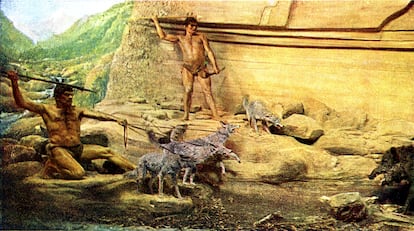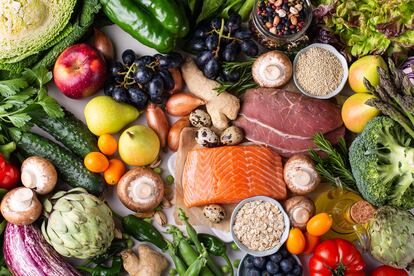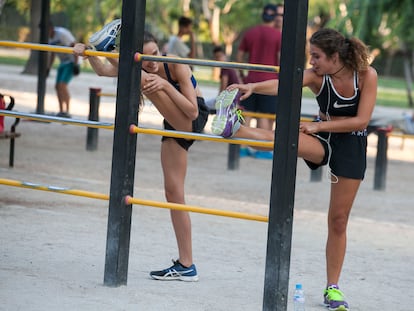From the paleo diet to going barefoot: ‘Wild health’ is in fashion
The latest health kick is based on the early human lifestyle and focuses on food, sport, and human connection: ‘It is not about returning to the caves, but rather taking advantage of the good aspects of the modern world while trying to recover the stimuli of the wild world,’ says one of its promoters

The main causes of death today are not plagues or famines, war or the flu. Today’s biggest killers are chronic diseases, such as cardiovascular diseases, cancer, and diabetes. In other words, the consequences (in many cases) of unhealthy habits. We are living longer, but we are less healthy. Experts highlight the correlation between these conditions, which were practically non-existent in ancient societies, and the modern world, where we are growing increasingly distant from nature. And some are advocating a simple solution: if modern civilization is killing us, it is time to return to our ancient origins.
This is precisely the argument made by Marcos Vázquez, creator of the Fitness Revolucionario [Revolutionary Fitness] blog and the Radio Fitness Revolucionario, a podcast on health and fitness. He is also the author of books such as Salud Salvaje, Invicto [Wild Health, Invictus] and Saludablemente [Healthily]. Vázquez maintains that the most common health problems today are the result of a conflict between biology and the current environment, a concept he calls “wild health.” “Based on this idea, we understand that most modern chronic diseases — whether we talk about diabetes, obesity, many types of cancer, cardiovascular problems, or mental disorders — are linked to the fact that we have reduced or eliminated the stimuli that our genes adapted to very well,” explains Vázquez.
These stimuli refer to natural foods, physical activity, strong social connections, and exposure to the elements that made up the environment in which we evolved. The problem is that not only have we eliminated these elements, but we have also replaced them with others, says Vazquez: “Now we have added stimuli in the modern world that we are not well adapted to, such as a sedentary lifestyle, processed foods, superficial online social connections, or too much exposure to artificial light.”
Civilization has evolved so quickly that our biology has not had time to adapt. To plug the gap, according to Vázquez, we should be exposed to the stimuli that existed in the environment between about 10,000 and 20,000 years ago (at the end of the Paleolithic period), when our ancestors still lived in hunter-gatherer societies. We should move like them, eat like them, strengthen our social connections, and increase our exposure to the elements: the sun, the cold, and the heat. This is an idea supported by movements such as the paleo diet, paleotraining, and “Earthing” (walking barefoot).
A species in motion
Moving like our ancestors has nothing to do with going to the gym for an hour. Natural movements, not weight machines or treadmills, have been the foundation of physical activity for thousands of years. This is where paleotraining comes from, the first training method based on the movements that Paleolithic man used to survive. According to what its founder, Airam Fernández, explains to EL PAÍS, these are movements that do not have to be taught. “Jumping, walking, and crawling are movements that are part of our neuromotor heritage. We developed them over so many millions of years that now these movement patterns are innate.” They have a lot more benefits than bicep curls and other isometric exercises because they take advantage of our genetics, and they are a workout for the whole body, not just one group of muscles. “Practicing natural movements helps develop strength, endurance, and coordination more efficiently,” says Fernández. Training this way strengthens the mind-body connection and, by promoting more balanced strength, helps prevent injury.
Paleotraining workouts go as far as possible to imitate the conditions and physical requirements of the wilder environment our ancestors lived in. Unlike classic training models, which follow a rigid and somewhat isolated structure, it is a more unstructured, holistic method. In nature, there are no Olympic dumbbells that are easy to grip, and there would never have been a need to do five sets of ten repetitions. For this reason, paleotraining works with objects such as logs, rocks, ropes, and your own body weight. Fernández points out that if we forget our origins as mobile beings, we end up with motor deficiencies, flexibility problems, muscular weakness, and unhealthy weight gain. All of this has serious implications for both physical and mental health and, therefore, our quality of life.
Eating for nourishment
Our ancestors would not have picked up a packet of cookies either. Their diet was based on plants, roots, tubers, fruits, eggs, seeds, and meat from all types of animals. Unlike modern diets, the Paleolithic diet was not based on the consumption of cereals, the prevalence of which in contemporary diets has had very negative effects on health: several studies and indicators point to the increase in gluten intolerance globally. According to experts, the main problem with today’s diet is processed foodstuffs. The body is not designed to consume them. “The consequences of not eating [a diet] based on what we are used to is that the physiological responses are harmful to the body,” explains Fernández. A poor diet causes inflammation, a factor that can be key in chronic diseases such as heart disease, diabetes, cancer, and Alzheimer’s. Cardiovascular diseases are the leading cause of death globally, according to the World Health Organization.
“The emotional effect that processed food and drinks have is brutal, and the food industry knows that perfectly well. Foods have been designed to give us instant gratification and make us feel better for a short time, producing a Pavlovian association between what we eat and how we feel. This is how addiction and constant dependence on these products are unleashed,” says Fernández. Marcos Vázquez, founder of Revolutionary Fitness, perfectly sums up the paradox: “We are overfed and undernourished.” On the other hand, the diets of our ancestors encourage anti-inflammatory responses and their benefits are overwhelming, Fernández and Vázquez point out. Among other factors, they improve glucose control and insulin sensitivity, promote the loss of fat, and reduce the risk of hypertension. In short, when we eat what the body really needs, we live better: we feel better, we have more energy, and we are not slaves to our cravings.

If depriving ourselves of physical activity and eating processed products is harmful to the body, so is living in too much comfort. We spend the day in offices, homes, and cars with devices to control the temperature. We wait until the water is hot enough to get into the shower. Most of us can’t imagine skipping breakfast. “These constant comforts have weakened us both physically and mentally,” says Marcos Vázquez, a certified training engineer in nutrition and disciplines such as CrossFit, kettlebells, and personal training. He talks about a phenomenon called hormesis, the idea that stress in small doses is favorable. Exposure to natural stressors such as natural light, hunger, cold, heat, or intensive exercise triggers essential adaptive responses and has positive impacts on health. Sunlight regulates our circadian rhythm, being in the cold and heat strengthens our thermoregulation systems, fasting can improve metabolism, and exercise strengthens all of the body’s systems, especially the cardiac system.
We are social beings
Another essential factor for human health is socialization, but not in the way that is common nowadays. The need to establish social connections is etched into our DNA, Francisco Giner Abati, professor of Anthropology at the University of Salamanca, tells us. In the past, we lived in tribes because that allowed us to survive more easily. “Living in a group is a phylogenetic adaptation and is not exclusively human, but something we share with other mammals. We reproduce only within the group, we help each other to survive by looking for food together and defending the group. Loneliness was a death sentence,” explains Abati. Therefore, our happiness is closely linked to social relationships.
Despite being more connected than ever, thanks to social networks, we are also more isolated. In some ways, loneliness is still a killer. “We suffer much more mental illness than our predecessors, who had a more humane and less stressful lifestyle,” Abati continues, highlighting the particularly harmful effects the modern way of socializing has on young people. “In these generations there is enormous social poverty, a desire for communication that is only partially fulfilled by social networks, because they are virtual. We have to make the effort to seek a more humane lifestyle,” says the professor.
The aim of so-called “wild health” is not for us to return to how we lived thousands of years ago. “It is not about going back to the caves, but rather taking advantage of all the good things about the modern world while we try to recover some of the stimuli of the wild world that will improve our physical and mental health,” explains Marcos Vázquez. Why? His answer is simple: to have a better quality of life. We should travel more, play with our children or grandchildren, avoid injuries, and most importantly, make the most of the fact that we are living longer than ever.
Sign up for our weekly newsletter to get more English-language news coverage from EL PAÍS USA Edition
Tu suscripción se está usando en otro dispositivo
¿Quieres añadir otro usuario a tu suscripción?
Si continúas leyendo en este dispositivo, no se podrá leer en el otro.
FlechaTu suscripción se está usando en otro dispositivo y solo puedes acceder a EL PAÍS desde un dispositivo a la vez.
Si quieres compartir tu cuenta, cambia tu suscripción a la modalidad Premium, así podrás añadir otro usuario. Cada uno accederá con su propia cuenta de email, lo que os permitirá personalizar vuestra experiencia en EL PAÍS.
¿Tienes una suscripción de empresa? Accede aquí para contratar más cuentas.
En el caso de no saber quién está usando tu cuenta, te recomendamos cambiar tu contraseña aquí.
Si decides continuar compartiendo tu cuenta, este mensaje se mostrará en tu dispositivo y en el de la otra persona que está usando tu cuenta de forma indefinida, afectando a tu experiencia de lectura. Puedes consultar aquí los términos y condiciones de la suscripción digital.
More information
Últimas noticias
Most viewed
- Sinaloa Cartel war is taking its toll on Los Chapitos
- Oona Chaplin: ‘I told James Cameron that I was living in a treehouse and starting a permaculture project with a friend’
- Reinhard Genzel, Nobel laureate in physics: ‘One-minute videos will never give you the truth’
- Why the price of coffee has skyrocketed: from Brazilian plantations to specialty coffee houses
- Silver prices are going crazy: This is what’s fueling the rally











































